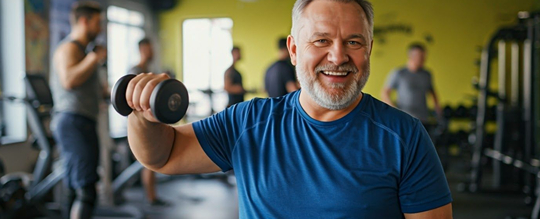The effects of obesity on bone and muscle health are often incorrectly described in the media and popular culture. Does an obese person have big bones? Is weight strength, and is excess weight an overwhelming advantage? As a medical professional, I want to shed light on this important but perhaps too often overlooked matter.
The Paradox of Obesity in Bone Density and Fracture Risk
A common belief is that higher body weight leads to stronger bones. Indeed, obesity is associated with increased bone mineral density. However, this does not directly mean a lower fracture risk.
Obesity Affects Fall and Fracture Risk
Especially in women, obesity has been shown to cause an increased risk of falling. Obesity has also been shown to be associated with an increased risk of bone fractures. Although continuously carrying excess fat mass increases bone mineral content, obesity also increases mediators of chronic inflammation and hormones that adversely affect bone metabolism and bone cell function.
Injuries Can Occur Even without Bone Fractures
Falling can, of course, cause other injuries besides fractures: ligament injuries, sprains, bruises, cerebral hemorrhages. The effect of obesity on the risk of these other fall-related injuries has not been as comprehensively studied, but there is no reason to assume that it would be a protective factor against them.
Fat Location Matters
Only central obesity appears to be associated with an increased risk of hip fracture, whereas adipose tissue concentrated in the hip region and lower body protects against hip and pelvic fractures. The location of excess adipose tissue thus affects which bones have an elevated fracture risk.
However, the combined risk of vertebral and all other fractures is elevated in women who have passed menopause, if their BMI is over 30.
Interaction between Muscle and Fat
In strongman and strongwoman competitions, competitors are often seen who have both muscle and obesity simultaneously. Can excess adipose tissue strengthen muscles?
It is logical to think that carrying extra weight would be good for muscles. In theory, this might be true if the carried adipose tissue were merely passive weight. However, adipose tissue is metabolically active and also secretes hormones.
Central Obesity Disrupts Muscle Communication
Especially in obesity concentrated in the abdominal area, previously mentioned inflammatory mediators are often found in the bloodstream, which interfere with muscle growth signals and impair the muscle’s ability to use proteins as building blocks. Insulin resistance associated with central obesity also manifests as the inappropriate accumulation of triglyceride fats within muscles. This disruption of muscle energy metabolism is one of the first steps in a chain that leads to an increase in blood triglyceride levels, type 2 diabetes, and fatty liver.
It is comforting that all these harms can be managed with even moderate weight loss and exercise combined with a healthy diet. Understanding the critical role of strength training, aerobic exercise, and stabilizing exercises in combating obesity-related health problems is important.
Muscle Function Recovers with Exercise
With the initiation of strength training, muscles relearn to use proteins for strengthening, reduce circulating inflammatory mediators, and improve energy metabolism. Strong muscles also provide better support for bones. This improved muscle support is a significant factor in reducing the risk of falls. Balance can be trained with separate exercises, but it can also be incorporated into either aerobic or strength training.
It has been shown that when both aerobic exercise and strength training are combined as part of weight loss, not only is more weight lost, but also better physical ability, stronger bones and muscles, and a better quality of life are achieved.
The many Functions of Protein
Muscles are largely built from protein-rich muscle fibers. Sufficient protein content in the diet, combined with muscle strength training, ensures that cells repair and renew muscle fibers, keeping muscles strong and durable.
Not all dietary protein ends up as building material for cells; the excess portion is consumed as energy by cells. Therefore, protein also contains calories, although half as many per gram as fat, but the same amount as sugar. When losing weight, it is advisable to reduce the amount of energy-dense food when aiming to consume fewer calories than expended. However, one must be somewhat careful here, as calorie reduction should not largely come at the expense of protein intake, so that weight loss occurs in fat rather than muscle.
How much Protein should You get?
The Finnish nutrition recommendations “Health from Food!” and “Vitality for Senior Years” recommend a sufficient protein intake of 1.1-1.3 g for those aged 18-64 and 1.2-1.4 g per kilogram of body weight for older individuals. For a person weighing 100 kg, this would mean 110-140 grams of protein per day. According to the extensive FinTerveys 2017 study conducted by THL in 2017, Finnish women consume an average of 73 g of protein per day, and men 98 g.
Studies where dieters have followed either a high-protein diet or a “normal-protein” diet have repeatedly indicated that, at least concerning muscle mass loss, aiming for more than 0.8 grams per kilogram of body weight is not beneficial.
Strength training has proven more important. Without active exercise intervention, for those who lost weight solely through diet, up to one-third of the lost weight can originate from muscle mass rather than fat.
More than just a Building Block
In nutrition, protein also serves another purpose for dieters. Namely, it increases the feeling of satiety and reduces the recurrence of hunger. Therefore, in a meal rhythm, each meal should ideally include a protein source. Too much protein intake can theoretically be harmful, but this is only possible with very extreme diets. If you follow a reasonably good and varied diet according to current understanding, you don’t need to worry about excessive protein intake. It is always appropriate to have a handful of nuts as a snack – unless you happen to be allergic to nuts.
A moderate pace of weight loss, sufficient protein intake, and exercise reduce muscle loss caused by dieting. If you are unsure about the sufficiency of your protein intake as part of your overall diet, I recommend booking an appointment with a nutritionist.
Step by Step towards Better Health through Exercise
How much should one exercise then? The correct answer is probably as much as you can. However, one must be kind to oneself, and even a small amount of activity should be considered a health act. According to THL’s FinTerveys 2017 study, one in three Finnish adult men and one in four women engage in recreational physical activity. For the majority of the population, therefore, every time one starts doing any exercise, it is already a great victory. From the perspective of maintaining health, the greatest benefit from the same amount of exercise is gained by a person who previously did not exercise at all.
Don’t just Lose Weight, Gain Health
Contrary to what may be shown in, for example, television reality shows, it is generally not sensible to aim for high calorie expenditure through strenuous athletic performance and lose weight this way. Although increasing exercise does increase your energy expenditure and facilitates weight loss, I personally perceive the benefits of exercise more in terms of quality of life.
An active daily life brings you vitality, relieves stress, improves sleep quality, and reduces many health problems. It thus brings more resources to your life. These resources are also needed in weight management, and to prevent weight cycling, physical activity should be a continuous part of your life, not a short and strenuous fitness regimen.
So, if you have not yet started making exercise a permanent part of your lifestyle, or if you have already gotten well into the swing of exercise but are wondering where you should focus your health-related physical activity, I will now give you some guiding tips.
Stay Active and Sit Less
Reducing sitting is an important goal from both a health maintenance and weight management perspective, and I recommend it to everyone. Stand up occasionally and walk a few laps around your chair when sitting for extended periods. Get off the bus a stop or two early. Park your car further away in the parking lot. Use the stairs, at least for some floors. Walk or cycle short distances, for example, to work and errands.
Get up and out – or Turn on the TV and Cycle
For the first steps in exercise, I recommend starting with light aerobic exercise such as walking, because there is such undeniably strong research evidence for its benefits. However, if your knees or ankles are symptomatic from walking, it is better to try an activity that puts less pressure on the lower limbs, such as stationary cycling or swimming/aqua jogging. A stationary bike can be placed even in front of the television if that makes getting on the bike easier and more relaxed. Even just over an hour of brisk walking per week reduces the risk of cancer, coronary artery disease, and death.
When performing moderately strenuous exercise, it probably doesn’t matter much whether it’s divided into a fifteen-minute burst every day or a longer workout twice a week. However, it is important to give the body enough time to recover from the previous performance. The time required depends on the intensity of the exertion, nutritional status, fitness level, and individual factors.
If and when it feels good to shift into a higher gear, it is smooth to transition from walking to Nordic walking, stair climbing, or even jogging. It’s good to challenge yourself when it feels right, but you shouldn’t exercise to extreme exhaustion if health and permanent weight loss are the goals.
Strength Training is Simple
Strength training often receives too little attention, even though it is easy and fast to do. Training the body’s largest muscles, i.e., the quadriceps and gluteal muscles, can be done as simply as
as calmly and controlledly squatting down without fully resting at the bottom, and then standing up. This movement is repeated ten to twenty times, a short break is taken, and the set can be done a couple more times. The depth of the squat, the correct number of repetitions and sets, is what feels good for you. Generally, 10-20 repetitions per set, and 2-3 sets are good, and this applies to all strength training exercises regardless of your level. Next, training the largest muscles, i.e., shoulders, chest muscles, and triceps, is easiest with dumbbells and resistance bands. Sufficient equipment can be found at your nearest supermarket. If you have enough time and motivation, it is certainly beneficial to go to a gym with high-quality and versatile equipment for strengthening both limb and core muscles, but going to the gym is not a prerequisite for good health and weight loss.
Start Gently, Continue at your Own Pace
Starting exercise as part of weight management can feel challenging at first, but it is important to remember that every small step is valuable on your journey towards a healthier life. It is understandable that there will be breaks or days when exercise feels difficult. This is completely normal and part of the journey.
Remember to Eat Enough, and at the Right Time
When losing weight, the body goes into “energy-saving mode.” Too strict an energy deficit combined with too strenuous exercise can lead to problems. In this state of overload, you may feel very exhausted and tired, and you will need a considerably long time to recover, at which point even a small amount of physical activity feels heavy, and in the long run, the amount of exercise remains small. Furthermore, the joy of exercise and the quality-of-life benefits I mentioned earlier are missing.
Such overload can be prevented not only by doing a suitable amount of appropriately strenuous exercise but also by eating enough. After exercise, it is generally advisable to have a snack containing carbohydrates and protein so that the activated muscles receive the necessary nutrients. It is also not advisable to embark on longer and more strenuous exercise sessions with too little nutrition.
Balancing sufficient nutrition with an energy deficit leading to weight loss does not have to be difficult if you take it easy and listen to your body. If necessary, ask for help from a nutritionist.
Ask for Help with Exercise Challenges
If you have challenges finding a suitable form of exercise for yourself due to, for example, pain or illnesses, do not hesitate to seek an appointment with a healthcare professional. Once your doctor has confirmed whether your illness is an obstacle to certain types of exercise, you can, for example, visit a physiotherapist to consider an individualized approach to exercise that is suitable for you.
Setting realistic and achievable goals is an essential part of this journey. Starting with small, manageable goals helps build self-confidence and motivation. Over time, the intensity and duration of exercises can be increased when you are ready.
Joy of Exercise and Feelings of Success for 2024!
This article has used, among others, the following sources:
- Ministry of Social Affairs and Health (2015). Sit less – feel better! National recommendations for reducing sitting (1st edition). Helsinki. Available at: https://julkaisut.valtioneuvosto.fi/handle/10024/74517
- National Nutrition Council (2018). Health from Food – Finnish Nutrition Recommendations 2014 (5th edition). Helsinki. Available at: https://www.ruokavirasto.fi/globalassets/teemat/terveytta-edistava-ruokavalio/kuluttaja-ja-ammattilaismateriaali/julkaisut/ravitsemussuositukset_2014_fi_web_versio_5.pdf
- Valsta, L., Kaartinen, N., Tapanainen, H., Männistö, S., & Sääksjärvi, K. (2018). Nutrition in Finland – FinRavinto 2017 study. THL Report 12/2018. Helsinki. Retrieved from http://urn.fi/URN:ISBN:978-952-343-238-3
- Koponen, P., Borodulin, K., Lundqvist, A., Sääksjärvi, K., & Koskinen, S. (2018). Health, Functional Capacity, and Well-being in Finland: FinTerveys 2017 study. THL Report 4/2018. Helsinki. Retrieved from http://urn.fi/URN:ISBN:978-952-343-105-8
- Villareal, D. T., Aguirre, L., Gurney, A. B., et al. (2017). Aerobic or Resistance Exercise, or Both, in Dieting Obese Older Adults. The New England Journal of Medicine, 376(20), 1943-1955. https://doi.org/10.1056/NEJMoa1616338
- Villareal, D. T., Chode, S., Parimi, N., et al. (2011). Weight loss, exercise, or both and physical function in obese older adults. The New England Journal of Medicine, 364(13), 1218-1229. https://doi.org/10.1056/NEJMoa1008234
- Bobowik, P., & Wiszomirska, I. (2021). The impact of obesity and age on the risk of falls in elderly women. Acta Bioengineering and Biomechanics, 23(2), 123-130.
- Mitchell, R. J., Lord, S. R., Harvey, L. A., et al. (2014). Associations between obesity and overweight and fall risk, health status and quality of life in older people. Australian and New Zealand Journal of Public Health, 38(1), 13-18. https://doi.org/10.1111/1753-6405.12152
- Himes, C. L., & Reynolds, S. L. (2012). Effect of obesity on falls, injury, and disability. Journal of the American Geriatrics Society, 60(1), 124-129. https://doi.org/10.1111/j.1532-5415.2011.03767.x
- Rinonapoli, G., Pace, V., Ruggiero, C., et al. (2021). Obesity and Bone: A Complex Relationship. International Journal of Molecular Sciences, 22(24), 13662. https://doi.org/10.3390/ijms222413662
- Batsis, J. A., & Villareal, D. T. (2018). Sarcopenic obesity in older adults: aetiology, epidemiology and treatment strategies. Nature Reviews Endocrinology, 14(9), 513-537. https://doi.org/10.1038/s41574-018-0062-9
- Liu, H. F., Meng, D. F., Yu, P., De, J. C., & Li, H. Y. (2023). Obesity and risk of fracture in postmenopausal women: a meta-analysis of cohort studies. Annals of Medicine, 55(1), 2203515. https://doi.org/10.1080/07853890.2023.2203515
- Sadeghi, O., Saneei, P., Nasiri, M., Larijani, B., & Esmaillzadeh, A. (2017). Abdominal Obesity and Risk of Hip Fracture: A Systematic Review and Meta-Analysis of Prospective StudiesGarcia, L., Pearce, M., Abbas, A., Mok, A., Strain, T., Ali, S., Crippa, A., Dempsey, P. C., Golubic, R., Kelly, P., Laird, Y., McNamara, E., Moore, S., de Sa, T. H., Smith, A. D., Wijndaele, K., Woodcock, J., Brage, S. (2023). Non-occupational physical activity and risk of cardiovascular disease, cancer and mortality outcomes: a dose-response meta-analysis of large prospective studies. British Journal of Sports Medicine, 57(15), 979-989. https://doi.org/10.1136/bjsports-2022-105669
Matias Blomqvist
Weight Management Physician










